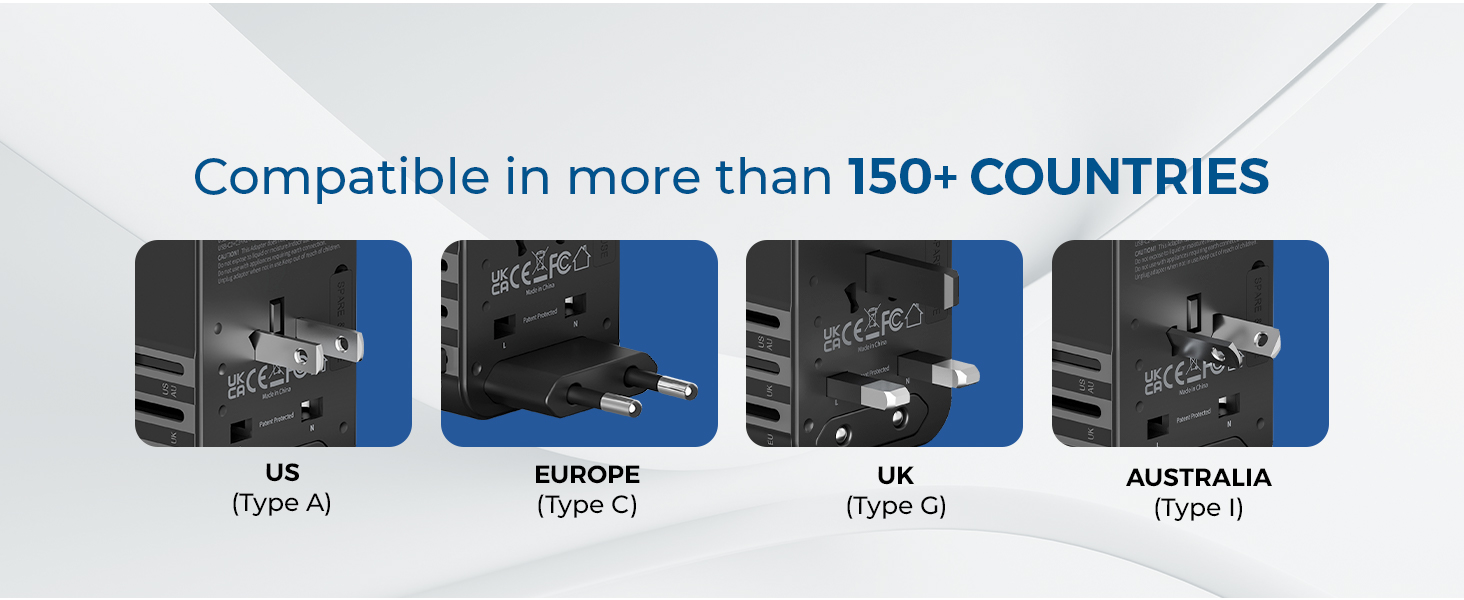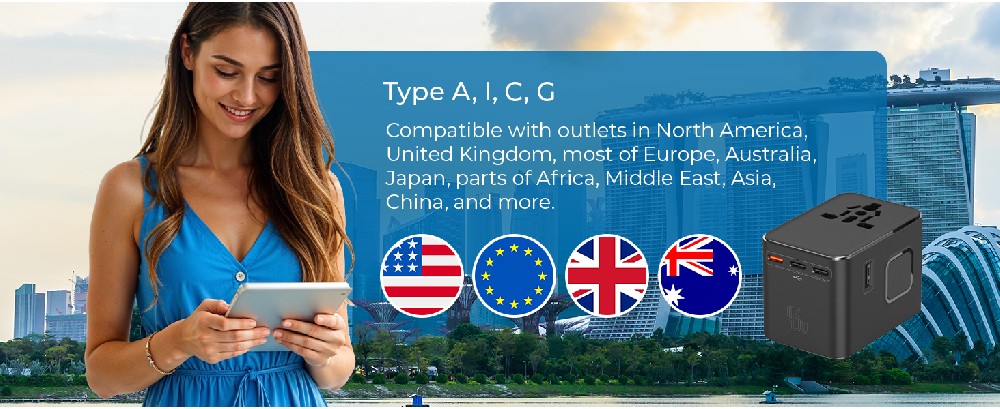Industry news
Don't Get Unplugged in Japan! Your Essential Travel Adapter Guide (2024)
Writer: admin Time:2025-07-24 16:02:19 Browse:394℃
Intro: Packing for Japan? Passport? Check. Yen? Check. Excitement? Off the charts! But hold up – can you actually charge that phone to capture the magic? Japan uses unique plugs and voltage. Forget your adapter, and you're stuck with a dead camera at Mount Fuji. This guide is your power solution, covering everything about Japan travel plug adapters. Let’s get you plugged in!
Why You Absolutely Need a Japan Travel Plug Adapter (The Problem)
Picture this: You land in Tokyo after a long flight. You reach your hotel, ready to charge your phone and camera. You pull out your trusty charger... and the plug won't fit the wall socket. Panic! Japan uses Type A and Type B sockets, with two flat pins (Type A) or two flat pins plus a grounding pin (Type B). If your devices have different plugs (like UK 3-pin, EU 2-pin, or Australian angled pins), they simply won't connect. This Japan travel plug adapter is your non-negotiable first step. Without it, your electronics are expensive paperweights. Trust me, I learned this the hard way when my UK laptop charger became instantly useless!
What Exactly is a Japan Travel Plug Adapter? (The Solution)
A Japan travel plug adapter is a small, simple device. It bridges the gap between your device's plug and Japan's wall sockets. Think of it as a physical translator. It doesn't change electricity voltage (that's a converter's job!), it just changes the plug shape so it fits. For most travelers, this adapter is the key component for charging phones, cameras, and laptops in Japan. They're lightweight, affordable, and slip easily into any bag. Here’s the kicker: Japan runs on 100 Volts, lower than North America (120V) and much lower than Europe/UK/Australia (220-240V). Luckily, most modern chargers (like phone/laptop bricks) handle 100V-240V automatically. Your adapter just gets them physically connected.

Japan vs. The World: Plug & Voltage Differences (Comparison)
Understanding the differences is crucial. Here's a quick breakdown:
| Feature | Japan | North America (US/Canada) | Europe (EU) | UK/Ireland | Australia/NZ |
|---|---|---|---|---|---|
| Socket Type | Type A, Type B | Type A, Type B | Type C, E, F | Type G | Type I |
| Voltage | 100V | 120V | 220-240V | 230V | 230V |
| Frequency | 50Hz (East), 60Hz (West) | 60Hz | 50Hz | 50Hz | 50Hz |
| Need Adapter from Japan? | N/A | No (Plug fits, voltage similar enough) | Yes (Different plug & voltage) | Yes (Different plug & voltage) | Yes (Different plug & voltage) |
| Need Voltage Converter? | Usually No (Most chargers dual-voltage) | Usually No | Check Device! (If not dual-voltage, YES) | Check Device! (If not dual-voltage, YES) | Check Device! (If not dual-voltage, YES) |
Choosing the BEST Japan Travel Plug Adapter (Function & Use Cases)
Not all adapters are created equal. Here's what to consider:
Your Home Country Plug: Match the adapter input to your plug type (US, EU, UK, AU, etc.).
Number of Ports: Traveling with multiple devices? Consider an adapter with multiple USB ports or even a built-in power strip. Charging your phone, power bank, and camera simultaneously is a game-changer! *(Statista reports over 65% of travelers carry 3+ electronic devices!)*.
Grounding Pin: Devices with 3-prong plugs (like some laptops) need an adapter supporting Type B (grounded) sockets.
Universal Option: Frequent traveler? A universal adapter covering Japan and other regions might be more cost-effective long-term.
Using Your Adapter in Japan: A Foolproof Step-by-Step Guide
Using your Japan travel plug adapter is simple:
Check Device Voltage: Look on your charger (the brick). It should say "Input: 100-240V" or similar. If it only says "Input: 220-240V", STOP! You need a voltage converter too (rare for modern chargers).
Plug In: Insert your device's plug firmly into the adapter.
Connect: Plug the adapter firmly into the Japanese wall socket (Type A or B).
Power On: Switch on the socket if it has a button (common in hotels).
Verify: Check your device is charging correctly. No sparks or weird smells!
Crucial Warnings & Common Mistakes (Don't Fry Your Gear!)
WARNING: VOLTAGE MATTERS!
Mistake 1: Plugging a high-wattage, single-voltage device (like a hairdryer or clothes iron marked only 220V) directly into the Japanese socket via an adapter. Result: It might work weakly, overheat, or get destroyed! Japan is 100V.
Mistake 2: Assuming an adapter changes voltage. IT DOESN'T. An adapter only changes the plug shape.
Mistake 3: Overloading a cheap adapter with too many high-power devices. Stick to charging phones, laptops, cameras.
Solution: For high-power appliances, either buy one in Japan (designed for 100V) or use a heavy-duty voltage converter. However, most travelers only need the adapter for low-wattage electronics.
Beyond the Basics: Adapters for Every Traveler
The Minimalist: A single, compact Type A/B adapter for your home plug is sufficient.
The Tech-Heavy Traveler: An adapter with 2-4 USB-A/USB-C ports is essential. Look for fast-charging options.
The Family/Group: Consider a small travel power strip plugged into one adapter. This lets everyone charge multiple devices at once without hunting for sockets. (A 2023 Skyscanner survey found socket availability is a top 3 hotel gripe for 48% of travelers!)
The Globetrotter: A high-quality universal adapter covering Japan (Type A/B) and most other regions is the most versatile investment.
Your Japan Power-Up Checklist (Before You Go!)
Don't leave power to chance! Pack these:
Japan Travel Plug Adapter(s) (Correct type for YOUR plugs + enough for your devices)
USB Charging Cables (For all your devices - phones, power banks, cameras, etc.)
Portable Power Bank (Essential for long days exploring!)
Checked ALL Device Chargers: Verified they say "Input: 100-240V" (or similar)?
(Optional but Recommended) Travel Power Strip / Multi-USB Adapter
Japan Travel Plug Adapter FAQs Answered
Q: Can I use my European plug in Japan with just an adapter?
A: Physically, yes, with the right Japan travel plug adapter. BUT, you MUST check your charger supports 100V (look for "Input: 100-240V"). If it only supports 220-240V, it won't work safely.
Q: Are Type A and Type B sockets common throughout Japan?
A: Yes! Type A (ungrounded) is very common, especially in older buildings. Type B (grounded) is increasingly standard in newer hotels and buildings. Your adapter should work with both.
Q: Can I buy a Japan power adapter when I arrive?
A: Yes, major electronics stores (like Yodobashi Camera, Bic Camera) or airports sell them. However, selection might be limited, prices higher, and why risk the hassle? Buy your reliable Japan travel plug adapter beforehand.
Q: Is a voltage converter necessary for charging phones in Japan?
A: Almost never. Phone/laptop chargers are almost universally dual-voltage (100-240V). Just use your adapter.
Q: Can I use my US plugs in Japan without an adapter?
A: Yes! US plugs (Type A/B) fit Japanese sockets. Just double-check voltage-sensitive devices (like hair dryers).
Conclusion:
Don't let a simple plug ruin your Japanese adventure! A reliable Japan travel plug adapter is tiny, affordable, and absolutely essential. Remember: Check your device voltages, pack the right adapter for your needs (consider extra USB ports!), and avoid plugging in high-wattage appliances not meant for 100V. By following this guide, you'll ensure all your devices stay charged and ready to capture every incredible moment, from Tokyo's neon buzz to Kyoto's serene temples. Now, go explore – you're powered up!
CATEGORIES
LATEST NEWS
- What are the differences in plugs (chargers) among countries around the world?
- Answers to frequently asked questions by customers
- Worldwide Plug Adapter with Fast Charging for Singapore South Korea
- The Ultimate Universal Travel Adapter with USB-C for Business Trips
- Choosing a Travel Plug Adapter for Germany France Business Trips
CONTACT US
WhatsApp: xxxxxx
Phone: 18128986700
Email: zhozuoplug@hotmail.com
Add: Dongguan City, Guangdong Province, China
